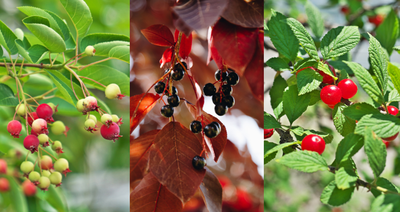Windbreaks Provide Foraging Opportunities
Many windbreaks in North Dakota are designed to provide us with warmth and protection from our miserable winters but did you know that many of them also provide foraging opportunities throughout the growing year? Proper identification is of the utmost importance before you consume anything, but I will share with you some of my favorite finds.
Though asparagus has gone to seed, now is a great time to learn if it is in your windbreak. It can easily be identified now by its ferny, bushy appearance. If you do find you have it, be sure to mark the spot with flagging or a GPS as it will come back up in the same place next year. I am amazed at how many landowners I visit every year that do not know that they have asparagus growing in their windbreak. They sure are thankful when I point it out to them as we visit at their property!
My ultimate favorite windbreak treat should be ripening and be ready for eating as you are reading this story and that my friend is Juneberry or Saskatoon Serviceberry. This wonderful fruit can be found growing in your windbreak and is one of my favorite fresh-picked fruits. It can also be frozen or processed. It typically is one of the first berries to ripen in the year. As you might think the name does imply when these berries are typically ready but for most of North Dakota I tend to find them more readily in the first few weeks of July, so begins my coming home with blueish-purple stained fingers from the handful of berries consumed from the day in the field.
One of the next berries just waiting to be picked is Nanking cherries. This tends to be a harder shrub to find in our windbreaks as it is not as common but the people who do have it love having the abundant red berries. If you are planning a new windbreak, consider adding a row of Nanking cherries or just plant a few bushes in your backyard like I did.
The next one that almost everyone should know is chokecherry. Typically these are turning ripe just before schools start back up, signaling the end of summer. These purple-colored berries can have a dry taste when eaten fresh, but they are wonderful to enjoy in a jelly or syrup. I have fond memories of picking these as a kid and selling them to our local winery, which we used to fund our weekend hunting trips.
Speaking of hunting—one of my favorite bushes to find is silver buffaloberry as this shrub produces tons of small red berries. The local wildlife love them, and when picked, they can make a thick, bright red jam. Just be careful when you are picking as they have large thorns that can cause some damage if you aren’t paying attention.
Some other edible goods you may find in a windbreak include apples, plums, walnuts, and currants, but again, be sure you properly identify what you are collecting. There are some fruits (like that of bush honeysuckle or common buckthorn) that look appetizing but should not be consumed. Our windbreaks aren’t just for wind protection; many have additional benefits, including the delicious fruits that can be enjoyed as a tasty treat for you and the local wildlife.
By Cody Clemenson, Forest Stewardship Specialist, North Dakota Forest Service




